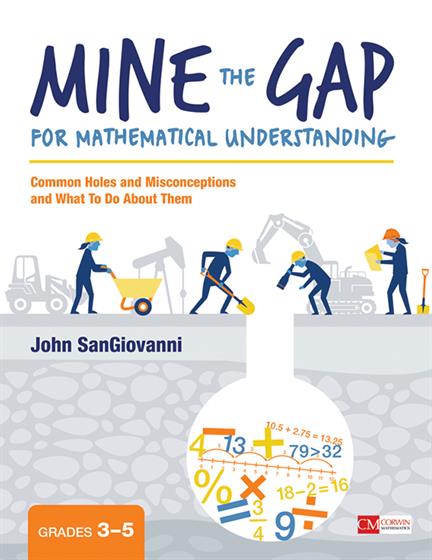Hands-on, Practical Guidance for Educators
From math,
literacy, equity, multilingual learners, and SEL, to assessment, school counseling,
and education leadership, our books are research-based and authored by experts
on topics most relevant to what educators are facing today.

Bestseller!
Mine the Gap for Mathematical Understanding, Grades 3-5
Common Holes and Misconceptions and What To Do About Them
It’s hard to find the time to figure out the ”why” behind students’ math mistakes, so here is a bank of 180 downloadable, standards-aligned math tasks, the common misunderstandings, and next instructional steps.
__________________________
A copy:
How good are you at exploiting students’ mathematical mistakes? In this remarkable book, John SanGiovanni reminds us that mistakes are not random, and when we take the time to “mine the gap,” we can dispel misunderstandings before they take root. Included are 180 downloadable high-quality tasks, aligned to the standards and big ideas grades 3-5 mathematics. Each task includes sample student work, commentary on strengths and gaps, and next instructional steps. Whether you use this bank of tasks for instruction or assessment, you will love how it helps you easily identify students’ thinking and then follow-up with instruction that brings clear, complete understanding.
__________________________
A copy:
How good are you at exploiting students’ mathematical mistakes? In this remarkable book, John SanGiovanni reminds us that mistakes are not random, and when we take the time to “mine the gap,” we can dispel misunderstandings before they take root. Included are 180 downloadable high-quality tasks, aligned to the standards and big ideas grades 3-5 mathematics. Each task includes sample student work, commentary on strengths and gaps, and next instructional steps. Whether you use this bank of tasks for instruction or assessment, you will love how it helps you easily identify students’ thinking and then follow-up with instruction that brings clear, complete understanding.
Product Details
- Grade Level: 3-5
- ISBN: 9781506337678
- Published By: Corwin
- Series: Corwin Mathematics Series
- Year: 2016
- Page Count: 384
- Publication date: October 10, 2016
Review Copies
This book is not available as a review copy.


